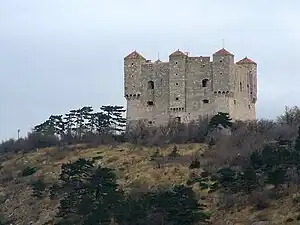Nehaj Fortress
The Nehaj Fortress [nexaj] (Croatian: Tvrđava Nehaj [tʋr̩dʑaʋa nexaj]) is a fortress on the hill Nehaj in the town of Senj, Croatia.
| Nehaj Fortress | |
|---|---|
| Native name Croatian: Tvrđava Nehaj | |
 Fortress Nehaj | |
| Location | Senj, in Lika-Senj County Croatia |
| Coordinates | 44.986°N 14.903°E |
| Governing body | Uskoci |
| Official name | Nehaj Castle |
 Location of Nehaj Fortress in Croatia | |
Name
The name Nehaj comes from the Croatian term Ne hajati [ne xajati], which means 'don't care'. In Croatian this fortress has also other names, which are: Kula Nehaj [kula nexaj], what means Nehaj Tower, and Nehajgrad [nexajɡrad], what means Nehajtown.
This name was given to the hill and the Fortress by the Uskoks, who built on the top of this hill the Fortress for defensive purposes. They gave the hill and the Fortress such a name because they wanted to emphasize to the citizens of the town of Senj, and all of those that lived in the vicinity of the town of Senj that they should not care that someone will conquer this hill or the Fortress until they are there.
Description
The fortress is 18 metres (59 ft) tall and 23 metres (75 ft) wide, and square shaped with walls averaging from 2 to 3 metres (6.6 to 9.8 ft) in thickness. There are five towers on top of the Fortress, and eleven large cannon openings along the walls. Inside the Fortress, there are displays of cannons and other household items, as well as a collection of costumes and weapons of the Uskoks of Senj. There is also an annual medieval festival that is held in Senj, and an important part of it is when the "Uskoks" march up to the fortress on horseback. There are also crafting workshops and other medieval themed attractions around the fortress at this time; as well as a detailed overview of its history.
Today, the fortress serves primarily as a museum.[1] With exhibits of weapons, clothing, drawings and models of various things from the time when the fortress was actively used.
History
The fortress was built by Croatian army general Ivan Lenković, a captain of the Uskoks, on the hill Nehaj.[1][2] Finished in 1558, it was built on the remains of ruined churches, monasteries and houses which were situated outside of the walls of Senj.[1] These buildings were scrapped since it was concluded that they would not survive anyway if they were outside the city walls, as the Ottomans would loot them or use them as housing during sieges. The fortress was mainly built to fight the Ottoman Empire, and to be used as a base for the Uskoks.
Gallery

 Roof of the Fortress
Roof of the Fortress The middle part of the inside of the Fortress
The middle part of the inside of the Fortress A look through a window on the north side of the Fortress
A look through a window on the north side of the Fortress Glagolitic stone of Senj, probably from the pre-romainc church of St.George. Dated around 1100, it is among the oldest documents written in Croatian.
Glagolitic stone of Senj, probably from the pre-romainc church of St.George. Dated around 1100, it is among the oldest documents written in Croatian. Remains from the pre-romanic church of St.George in Senj (11th-12th century), burnt down during the Turks' attack of 1520
Remains from the pre-romanic church of St.George in Senj (11th-12th century), burnt down during the Turks' attack of 1520 Remains from the pre-romanic church of St.George in Senj (11th-12th century), burnt down during the Turks' attack of 1520
Remains from the pre-romanic church of St.George in Senj (11th-12th century), burnt down during the Turks' attack of 1520 Senj Nehaj coat of arms
Senj Nehaj coat of arms Senj Nehaj coat of arms
Senj Nehaj coat of arms Senj Nehaj coat of arms
Senj Nehaj coat of arms
See also
References
Footnotes
- Bousfield (2003), p. 227.
- Senj culturenet.hr
Bibliography
- Bousfield, Jonathan (2003). The Rough Guide to Croatia. London: Rough Guides. ISBN 978-1-84353-084-8.
External links
- The official web-site of the Nehaj Fortress Archived 2008-03-03 at the Wayback Machine
